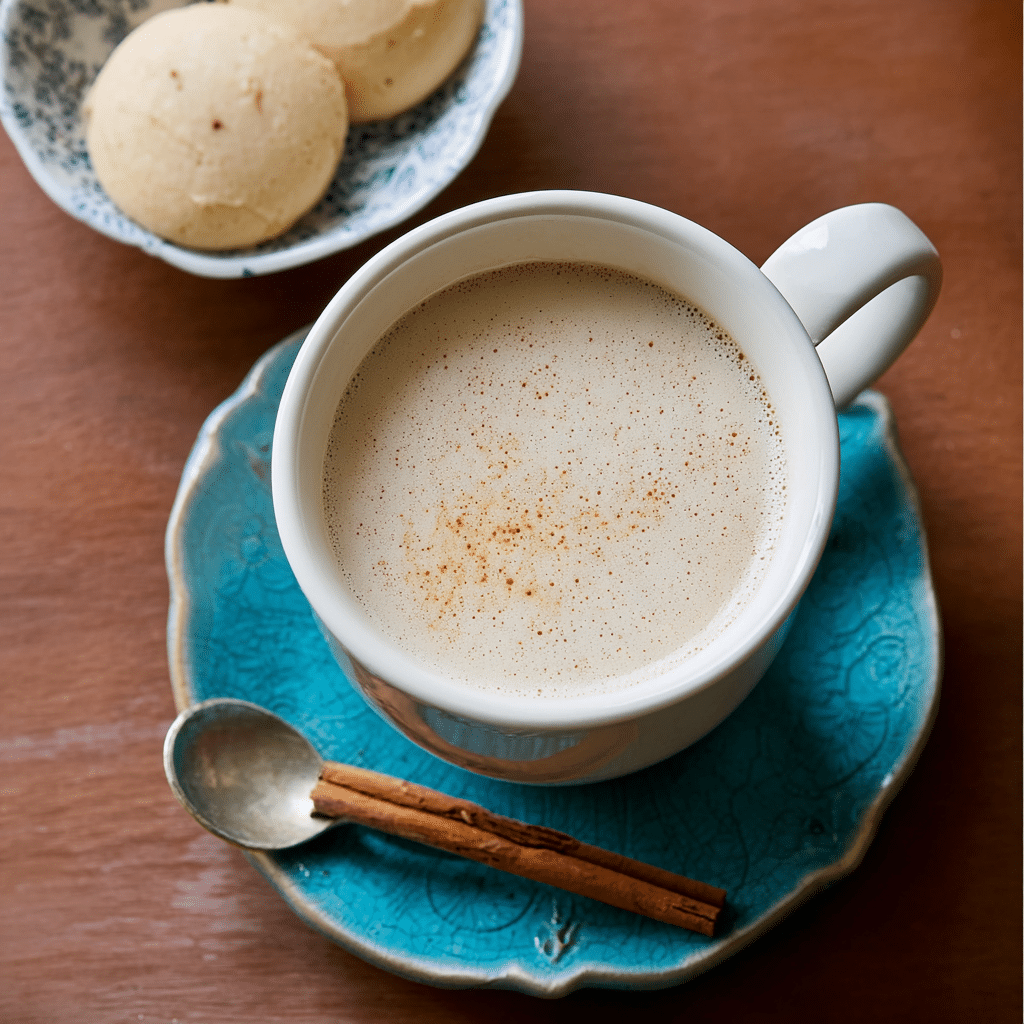The Atole de Mazapán is a rich, velvety Mexican drink made with beloved mazapán candies, masa harina, and whole milk. With notes of cinnamon, vanilla, and peanuts, it’s like a nostalgic blend of a warm dessert and a comforting beverage. Traditionally enjoyed during holidays, street festivals, or cool evenings, this atole is the definition of soul-soothing.
The beauty of this drink lies in its creamy thickness and distinct peanut flavor, which blends seamlessly with the earthy undertones of masa and the warmth of cinnamon. Perfect for sipping slowly while wrapped in a blanket, Atole de Mazapán is more than just a drink—it’s a hug in a mug with deep cultural roots.
Full Recipe
Ingredients:
-
4 cups whole milk
-
1 1/2 cups water
-
5 mazapán (Mexican peanut marzipan candies)
-
1/2 cup masa harina (corn flour for tamales)
-
1/2 cup sugar (adjust to taste)
-
1 cinnamon stick
-
1 tsp vanilla extract
-
Pinch of salt
Directions:
-
In a small bowl, mix the masa harina with the water until smooth. Set aside.
-
In a large saucepan, heat the milk with the cinnamon stick over medium heat until it starts to steam—do not boil.
-
Crumble the mazapán candies and add them to the warm milk, stirring until completely dissolved.
-
Slowly whisk in the masa harina mixture into the saucepan, stirring constantly to avoid lumps.
-
Add sugar, vanilla extract, and a pinch of salt.
-
Continue to cook over low-medium heat, stirring frequently, until the atole thickens to your desired consistency (about 10–15 minutes).
-
Remove the cinnamon stick, pour into mugs, and serve warm.
Prep Time: 5 minutes | Cooking Time: 15 minutes | Total Time: 20 minutes
Kcal: 285 kcal | Servings: 4 servings
Introduction to Atole de Mazapán
Atole de Mazapán is a decadent and comforting traditional Mexican beverage that embodies the warmth, nostalgia, and rich culinary heritage of Mexico. This thick, velvety drink is a variation of the classic atole, which has been enjoyed since pre-Hispanic times. The defining twist in this version is the use of mazapán, a crumbly, peanut-based candy that adds a nutty sweetness and creamy body to the atole, creating a drink that’s both heartwarming and indulgent.
Unlike coffee or hot chocolate, atole de mazapán offers a unique blend of earthy corn masa, sweet peanuts, milk, and fragrant spices like cinnamon and vanilla. The result is a smooth, thick beverage that’s traditionally enjoyed for breakfast or as a snack, especially during colder months, festive occasions, or holidays like Día de los Muertos and Las Posadas. With its sweet, nutty undertones and a texture akin to a light porridge, this atole is more than a drink—it’s a tradition in a cup.
Cultural Significance of Atole in Mexican Cuisine
Atole has deep roots in Mesoamerican cuisine, originating with the Aztecs and other Indigenous peoples of central Mexico. Originally made with water and corn masa, it served as a nourishing beverage to sustain energy throughout the day. Over time, with the arrival of European influences, ingredients like milk, sugar, and spices were introduced, evolving atole into countless regional and seasonal variations.
Atole de Mazapán represents a more modern and playful version of the drink, merging traditional methods with the iconic Mexican mazapán candy, a staple of many childhoods and street food stalls. This creative take reflects how Mexican cuisine often balances history and innovation, using readily available ingredients to transform everyday recipes into cultural treasures.
Today, atole is more than just a drink—it is an integral part of celebrations, breakfast tables, and family gatherings. Whether served alongside tamales during holiday feasts or enjoyed solo as an evening comfort, atole in all its forms brings people together and passes on culinary stories from generation to generation.
The Role of Mazapán in the Recipe
Mazapán is a beloved Mexican confection made from crushed peanuts and sugar, typically pressed into disks and wrapped in brightly colored paper. Unlike its European marzipan counterpart, which is almond-based, Mexican mazapán has a uniquely crumbly, melt-in-your-mouth texture and a deep roasted peanut flavor.
When added to atole, mazapán not only contributes sweetness but also enhances the drink’s creaminess. Its nutty richness complements the earthiness of the masa harina while blending seamlessly with the milk and vanilla, creating a smooth, luxurious beverage. This combination is especially comforting during the fall and winter seasons when warm, thick drinks are favored.
For many, the taste of mazapán evokes childhood memories—trading candies at school, enjoying a treat from the local tiendita, or breaking one open during birthday piñata celebrations. By incorporating it into atole, the drink takes on layers of sentiment, tradition, and flavor.
Texture and Flavor Profile
Atole de Mazapán is known for its silky, pudding-like consistency. Unlike thinner beverages, it has a viscosity that makes it feel hearty and satisfying, almost like a drinkable dessert. The use of masa harina gives it a slight graininess reminiscent of cornmeal, but when properly mixed and simmered, the result is a smooth, velvety texture that coats the palate.
Flavor-wise, this atole delivers a balanced sweetness with a nutty depth from the mazapán. The milk adds body and richness, while cinnamon and vanilla contribute warmth and aroma. It’s not overly sugary, making it suitable for those who prefer natural sweetness. The combination of flavors is both nostalgic and indulgent, yet familiar and comforting.
This balance of flavors and textures makes atole de mazapán incredibly versatile—it can be sipped slowly on its own or paired with pan dulce, tamales, or even cookies for an authentic Mexican treat.
When to Serve Atole de Mazapán
This atole is often enjoyed during special times of year or meaningful family gatherings, but it can just as easily become a part of your daily morning or evening routine. It is especially popular during fall and winter, making it a cozy option for chilly days.
In Mexican households, it’s commonly served at breakfast or merienda (afternoon snack), alongside tamales or churros. During holidays like Día de los Muertos or La Candelaria, it plays a ceremonial role, often served after religious observances or community processions.
Beyond festive settings, atole de mazapán is ideal for weekend brunches, casual get-togethers, or whenever you crave something indulgent yet simple to prepare. Because it is both drink and dessert in one, it satisfies without needing much accompaniment.
Nutritional Value and Adaptations
While traditional atole de mazapán is made with whole milk and sugar, the recipe is easily adaptable to suit dietary needs or preferences. For a vegan version, you can substitute dairy milk with plant-based alternatives like almond, oat, or soy milk. Natural sweeteners such as agave syrup or maple syrup can replace refined sugar.
Masa harina is naturally gluten-free, making the recipe suitable for those with gluten sensitivities, provided other ingredients are certified gluten-free. Additionally, the thickness of the drink makes it quite filling, meaning a small cup can go a long way in satisfying hunger or cravings.
Mazapán itself contains peanuts and sugar, so this atole is not suitable for those with peanut allergies. However, there are peanut-free marzipan options or nut butters that could be used as a creative workaround.
Tips for the Perfect Atole de Mazapán
Achieving the ideal consistency and flavor in atole de mazapán is all about attention to detail and patience. Here are a few expert tips:
-
Whisk constantly: Masa harina can clump easily if not stirred properly. Use a whisk when adding it to the warm liquid to ensure a smooth blend.
-
Simmer gently: Avoid boiling the milk to prevent curdling or scorching. A gentle simmer is all you need to extract flavors and thicken the atole.
-
Taste as you go: Depending on how sweet your mazapán is, you may want to adjust the amount of added sugar.
-
Serve immediately: Atole thickens as it cools, so it’s best enjoyed right after cooking. If reheating, add a splash of milk or water to loosen the consistency.
Why You’ll Love This Drink
There’s something profoundly comforting about a warm mug of atole de mazapán. It’s more than a beverage—it’s a culinary embrace. From the richness of roasted peanuts to the nostalgic aroma of cinnamon, every sip is a sensory trip through Mexico’s culinary landscape.
Whether you’re introducing this drink to someone for the first time or reliving cherished memories from your childhood, it offers a heartfelt connection to tradition. It’s easy to prepare, endlessly customizable, and universally loved by kids and adults alike.
Even if you’ve never tried atole before, this mazapán-infused version is a perfect introduction to the world of Mexican hot drinks.
Conclusion
Atole de Mazapán stands as a beautiful example of how traditional Mexican ingredients can be transformed into something both familiar and extraordinary. Blending Indigenous culinary roots with the sweetness of a beloved candy, this drink offers history, comfort, and flavor in every cup.
Whether you’re savoring it during a quiet morning, sharing it with friends at a holiday gathering, or introducing it as a new family favorite, atole de mazapán has the power to warm hearts and bring people together. It’s a drink that tells a story—of culture, family, and the simple joys of homemade tradition.
If you’re looking for something that’s easy to prepare, rich in flavor, and steeped in meaning, then atole de mazapán deserves a spot in your kitchen and on your table.






